|
United States : Oklahoma
10.5 miles (16.9 km) NW of Vinson, Harmon, OK, USA
Approx. altitude: 562 m
(1843 ft)
([?] maps: Google MapQuest OpenStreetMap topo aerial ConfluenceNavigator)
Antipode: 35°S 80°E
Accuracy: 3 m (9 ft)
Quality:
Click on any of the images for the full-sized picture.
| 35°N 100°W (visit #4) |
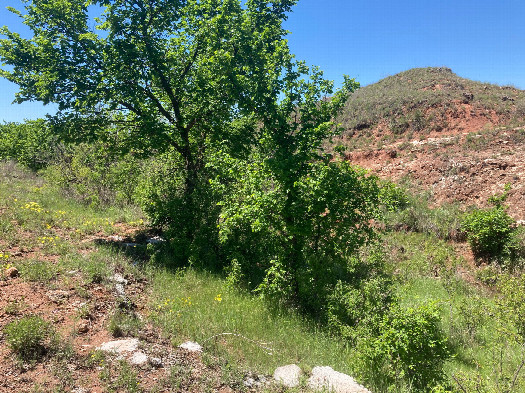 (visited by Michael G and Jack S) 03-May-2025 -- Today Jack and I made a long-awaited return to 35°N, an appropriate activity for the 3rd of May ("3-5 Day", if you will). I never thought I'd describe a line of latitude as my 'favorite', but if I had to pick one, I'd say the 35th parallel takes the cake; this latitude has produced a number of enjoyable confluence adventures over the last year. Today's visit to its crossing of the 100th meridian west only reinforced my esoteric belief. On a beautiful May morning, we found ourselves heading westbound on OK 152 eventually en route to the Oklahoma/Texas border, 100°W. About halfway between OKC and 35N 100W, we spotted a large Boeing plane lazily flying back-and-forth in a very unusual way — as far as we knew, a typical passenger plane wouldn't be going in circles over west-central Oklahoma. Thanks to the convenience of flight tracking apps I found out that it was a Boeing 777-9, a new airline model in flight testing stage, expected to be deployed in 2026. According to the app, the plane had taken off from the Clinton-Sherman Industrial Airpark and had been in the air for over three hours, almost certainly getting tested on this very calm and clear day. An interesting sighting for sure! After a short stint on I-40 (from Sayre to Erick), we exited the freeway onto old Route 66 and followed it into Texas, just past the tiny town of Texola. We split south from Route 66 about two miles (3 km) into Texas, at County Road 29 — in the interest of seeing as much as possible of the area, we'd opted to try a longer approach to the confluence from the north, a decision that paid off. This dirt road was definitely on the rougher side in spots (not ideal for low clearance vehicles), but made a very scenic drive through hilly green ranchland: among the prettiest pre-confluence drives we've done up to now, proving (once more) that the Southern Plains isn't all flyover country. Tire ruts suggested that the road had been muddy in the recent past, but today's sunny skies kept it nice and dry — a good thing since cell coverage was minimal out here. We remained on this occasionally winding road for about 20 minutes to a junction with the eastern terminus of Farm-to-Market Road 1439, before following a couple (still dirt) grid roads east and south to a good starting point for our walk. The parking spot, roughly a half mile (750 meters) west of the goal, was used by Joseph Kerski and Ross Finlayson in their respective 2022 and 2024 visits. This is now an odd confluence with three 2020s visits and only one before that! The hike started smoothly in an idyllic springtime setting, with bright green, shin-deep grass and trees covering a gently rolling landscape. Patches of red-orange and yellow wildflowers peppered the grassland, while clusters of cacti resided in drier spots with exposed dirt and rock. The juxtaposition of landcovers reminded me of the significance of 100°W, an approximate boundary between the dry expanses of the western United States and the rainier eastern half. We made it about 25% of the way to the goal before encountering what's become an extremely common sight during our confluence walks: cows. We'd heard them in the distance up to that point, but now saw several in our way (including a couple calves). This bovine family was a bit skiddish and we took care to avoid their favored hangout spot by detouring north: better to extend the walk than to get run over by the local residents. We felt good after putting some distance between us and them, and for extra situational awareness we tried to keep to ridges where we'd be able to scope out any further animals from a distance. Fortunately there we no more to be seen for the remainder of the hike, except the same group of cows on our way back! Just under 300 meters west of the confluence, we crossed a farm track; this north-south oriented path could've been a nice alternate route (coming from either direction) if we hadn't chosen to start our walk from the nearest spot on the road. One would certainly avoid any snake or tick risk going that way, though thankfully neither pest ever materialized for us. A few minutes later we unknowingly crossed the invisible boundary into Oklahoma and happened upon the briefly steep descent into Coon Creek's gully (from the northwest). This was a pretty sight, made better by a narrow trail-like feature that allowed us to easily move down the gully's edge to the creek — it was no steeper than any "real" hiking trail one might encounter. As expected during the middle of this unusually wet rainy season, Coon Creek was flowing healthily, just wide enough that we had to jump across (instead of stepping). As established by previous visits, the confluence is on the east side of the creek by a couple meters; I was glad that I'd perform the zeroes dance on dry ground, as fun as knee-deep wading would be. It took me a moment to orient myself, but I eventually found the all-zeroes location: with great satisfaction, Jack and I had arrived at 35N 100W. This was a particularly exciting spot, being one that appears on 5° lat/lon grid maps — our first 'divisble by 5' confluence visit. It was a wonderful place to be this afternoon: the air was almost perfectly still and mild, with a temperature in the mid 60s (18°C) under a cloudless sky. From the confluence we only heard the sound of the flowing creek (too far to hear the cows). A couple trees lay within an arm-length of confluence to the southwest, a nice source of shade if we'd needed it. Some yellow wildflowers made their home down here this spring, interesting since there weren't any in the photos from last April. (Maybe they have a very specific blooming period.) On a "real" hike, this point would be a great resting/snacking spot. After a few minutes, we started our ascent out of the gully, leaving via the same trail-like path to our north. Once back on the rolling landscape, we more or less retraced our steps with a 50 to 150 meter northward adjustment in light of earlier cow sightings. This slight shift made the walk back a lot more relaxed, and we made it from the confluence to the car about 10 minutes faster than our car-to-confluence walking time. With the mission completed, we continued the drive south along the road we'd parked on, turning east at the next T junction. We crossed into Oklahoma (again, though driving this time) and continued for 5 miles (8 km) to OK 30; previous visitors have gotten to 35N 100W by going west on this road, E 1400. From here we started our return toward I-40, having not seen another vehicle since hitting dirt roads nearly two hours earlier. For its combination of isolation, scenery, and weather, this was probably our favorite Oklahoma confluence visit to-date: another 35°N classic. |
| All pictures |
| #1: Looking southwest at 35N 100W, located in the grass in front of the treees #2: Looking north from the confluence #3: Looking east, up the gully's edge #4: Looking south #5: Looking west, toward the creek #6: Lots of zeroes on the GPS! #7: A green scene along our walk #8: A patch of cacti #9: Coon Creek, just a few meters west of 35N 100W #10: Scenic dirt road used on the way to the spot ALL: All pictures on one page |

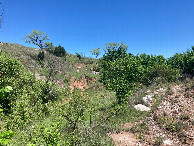
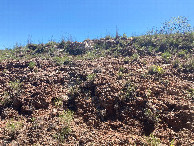

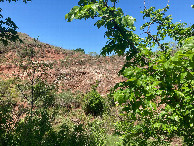
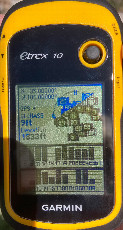
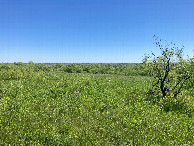
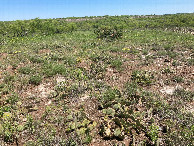
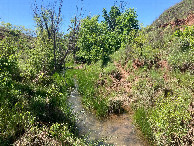
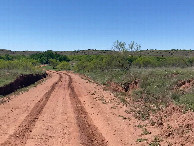
![Visit #3: [14-Apr-24] Visit #3: [14-Apr-24]](/us/ok/n35w100v3/preview.jpg)
![Visit #2: [18-Sep-22] Visit #2: [18-Sep-22]](/us/ok/n35w100v2/preview.jpg)
![Visit #1: [28-Oct-01] Visit #1: [28-Oct-01]](/us/ok/n35w100/preview.jpg)